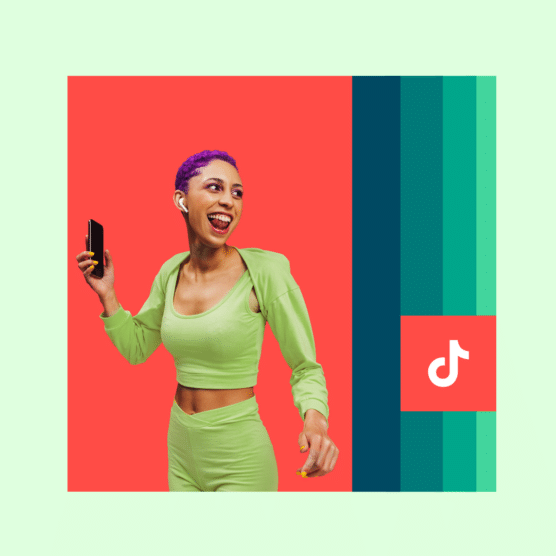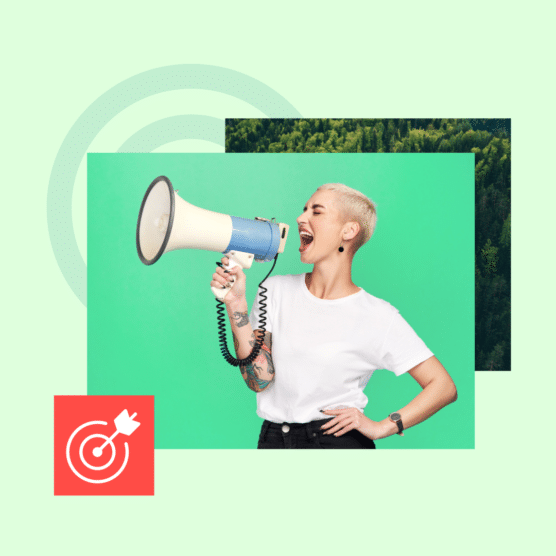Reputation is everything. That’s why it’s crucial for marketers to take steps to protect their brand safety online, especially when it comes to social media.
Social media does a great job of building brands and connecting businesses with their customers. But it also comes with the risk of associating a brand’s goods or services with content that can harm its reputation.
In this article, we’ll share brand safety statistics, strategies and best practices that marketers can use to safeguard their brand’s reputation on social media. From monitoring and social listening to knowing when to go dark, we’ll provide actionable steps to maximize the safety of your brand online.
What is brand safety?
Brand safety means ensuring that a business’s ads aren’t associated with inappropriate content that could damage the brand’s reputation. This includes creating policies and measures to protect the brand from appearing alongside content that could be offensive, controversial, illegal or unethical.
Brand safety is most often discussed in the context of paid ads. That’s because social media ads can be a big investment — but they can also pose a serious risk. In 2021, brands spent $181.2 billion globally on social advertising, and that number has only increased since then.
But brand safety isn’t just about paid media. It also applies to organic social or really anywhere that a brand could appear online. In recent years, people have even started talking about “brand suitability,” which is less about avoiding risk and more about proactively associating your brand with positive placements that reinforce your existing reputation.
Why does brand safety matter?
Taking a proactive approach to brand safety is the best way for marketers to safeguard their brand’s reputation. And your brand’s reputation matters — a lot.
A strong brand reputation means the public considers your brand trustworthy. When you’ve earned someone’s trust, they’re more likely to do business with you and recommend your services to others. A negative brand reputation, though, can tank sales and cause major damage to your brand.
In fact, 67% of consumers say they would likely stop using a brand’s product or service if they saw the brand’s advertising alongside false, objectionable, or inflammatory content.
A brand safety incident can also damage your brand’s relationships with partners, suppliers, and other collaborators.
No matter how big or small your digital marketing budget is, spending time to optimize brand safety will help you make the most of your dollars spent.
Brand safety risks
Advertising next to inappropriate or offensive content
In programmatic advertising, advertisers buy ad placements through distribution platforms, rather than individual publishers.
It’s an efficient way to buy targeted ads with wide reach. But it also means advertisers don’t have full control over where their ads appear.
This can mean your social media ad may appear next to inappropriate or harmful content. Here’s an example of a potential brand safety issue:
Source: Reddit
In this case, the advertiser likely targeted the keywords “THC” and “cannabis.” They probably didn’t expect that their ad would appear next to an article about a negative incident caused by a cannabis product.
Source: Reddit
Yikes. In this example, the advertiser could have avoided this placement by adding names of unsuitable publishers to their keyword blocklist.
Endorsing problematic influencers
Collaborating with a public figure, influencer, or content creator can expand your brand awareness. However, these opportunities also come with more risks for brands.
Influencers often share their personal views and opinions on their channels. These opinions may not always align with past or present partners.
One example: the almost decade-long partnership between Adidas and Kanye West’s “Yeezy” product line. This long collaboration came to an end in late 2022 after Kanye West’s public anti-Semitic comments.
The end of this partnership mean Adidas dropped a product line and lost out on big sales numbers. But the brand determined that associating with a public figure who went against their values posed a bigger risk.
Using a hashtag associated with risky content
When launching a new campaign or content series, hashtags can really help improve reach and engagement. But you have to do your research first. Otherwise, you risk your brand’s posts showing up in a search with unsafe content.
The online clothing retailer, Dorothy Perkins, discovered this the hard way after deciding to use the hashtag #LoveDP. (Don’t Google it, just trust us.)
Paying for fraudulent clicks
If you’re not careful with your placements, programmatic advertising also risks attracting bad traffic. If your brand’s ads appear on unsavory websites or alongside fake news, your website can become targeted by bad actors like bot traffic.
Why is this bad? Non-relevant traffic will hurt your site’s conversion rates. Bot traffic can also weaken your position in search results rankings. In 2020, ad fraud cost businesses $35-40 billion.
Brand safety may be one of the biggest challenges for brands online, largely due to the UGC nature of social media platforms. After all, you can’t stop users from mentioning your brand alongside offensive content.
However, we’ll tell you six things you can do to protect your brand safety.
1. Establish a social listening strategy
Social listening is a marketer’s best line of defense when it comes to avoiding brand safety incidents.
With a tool like Hootsuite, you can use multiple streams to do things like:
- Set alerts for your brand name + “crisis keywords/phrases,” such as “disaster,” “nightmare,” “accident,” “horrific,” and “never again”
- Set thresholds to detect spikes in mentions, messages, and comments
- Monitor your brand for large changes in sentiment, which may indicate a negative or positive customer situation
You can also use an advanced social listening tool like Hootsuite Insights. Insights can help you monitor social sentiment over time and put out (metaphorical) fires before they start.
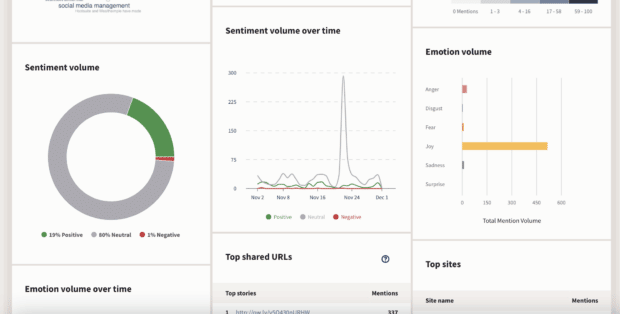
Request a Demo of Hootsuite Insights
2. Make a social media crisis plan and response strategy
What’s just as important as having a well-planned, strategy-based content calendar? Knowing when not to post.
A social media crisis plan is a great tool to protect your brand’s safety. Here’s what it should include:
- Criteria for when to pause posts during major world events (and criteria to decide when to resume posting)
- Guidelines for responses to large volumes of customer complaints and issues
- Messaging approval processes and contact information for key stakeholders required for approvals
- Internal communications plan
With Hootsuite, you can pause all posts with one click and show a warning for all users in your organization.
3. Create a social media employee policy
These days, more and more employees are creating content related to their employers. But with any collaboration, there’s risk.
Employers can’t control employees’ personal profiles. That means even employee-generated content can jeopardize brand safety.
One way to mitigate this risk is to establish a social media policy. These documents outline what employees can and can’t do. They also explain how to be good employee advocates.
4. Monitor (and respond to) all comments and messages
Even if the content you post to your accounts is carefully curated and well-aligned with your social media policies, public comments and messages left by followers (or trolls) may be far from it.
To make sure that you never miss a tricky message, use a unified social media inbox to capture interactions from all of your accounts.
With Hootsuite Inbox, you can bridge the gap between social listening, brand safety, engagement, and customer service — and manage all of your social media messages in one place. This includes:
- Private messages and DMs
- Public messages and posts on your profiles
- Dark and organic comments
- Mentions
- Emoji reactions
… and more.
The all-in-one agent workspace makes it easy to
- Track the history of any individual’s interactions with your brand on social media (across your accounts and platforms), giving your team the context needed to personalize replies
- Add notes to customers’ profiles (Inbox integrates with Salesforce and Microsoft Dynamics)
- Handle messages as a team, with intuitive message queues, task assignments, statuses, and filters
- Track response times and CSAT metrics

Plus, Inbox comes with handy automations:
- Automated message routing
- Auto-responses and saved replies
- Automatically triggered customer satisfaction surveys
- AI-powered chatbot features
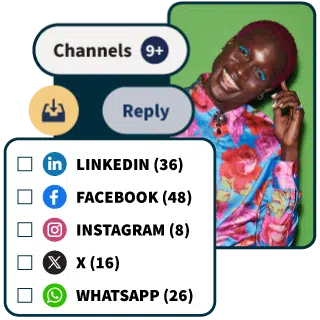
Manage all your messages stress-free with easy routing, saved replies, and friendly chatbots. Try Hootsuite’s Inbox today.
Book a Demo5. Define your brand’s safety threshold
Before executing a brand safety strategy, you’ll need to know your brand’s risk tolerance.
Some topics, like pornography, terrorism, and misinformation, are obvious no-gos. But depending on their values, brands may also choose to avoid topics like religion, politics, and nudity.
Most ad platforms offer the option to choose different risk levels of content your ads will appear adjacent to. The levels range from limited (least risky, less reach) to broad (more risky, higher reach).
6. Use negative targeting
If you know there are terms or phrases that you never want your brand’s content to be associated with, you can input a list of these terms as “negative keywords” into a blocklist to avoid related placements.
Be wary, though, as negative targeting can decrease your reach unintentionally. For example, a word like “knife” may exclude cooking videos or recipe blogs.
Pro tip: Use your brand’s safety threshold and brand values to come up with negative keywords. Make sure to update them regularly, and consult your social care and customer service teams for terms to include.
Platform-by-platform brand safety best practices
Facebook & Instagram brand safety tips
Meta’s created a Brand Safety Hub where marketers can customize their brand safety settings which apply to ads shown across Facebook, Instagram, Messenger, Whatsapp, and the Meta Audience Network.
Before running your next Facebook or Instagram ad campaign, we recommend reviewing the following settings in your Brand Safety Hub:
- Inventory filter. Marketers can choose the sensitivity level of the content that ads can appear within. Note that when choosing limited inventory, your reach will be reduced and you may pay higher ad costs.
- Block list. Allows you to input specific URLs, Facebook pages, or Instagram profiles where you don’t want ads to appear.
- Topic exclusions. If you’re running in-stream video ads, you can opt out of specific placements in videos about gaming, news, politics, and religion & spirituality.
- Delivery reports. If you’re not sure which sources to add to your block lists or exclusions, you can review delivery reports to see where your past ads were shown. If you spot a publisher or placement that you want to avoid in the future, you can add it to your block list directly from the report.
Learn more about Facebook’s brand safety controls.
Twitter brand safety tips
Given its roots as a conversation-focused platform, there has always been a higher level of scrutiny on Twitter’s brand safety risks.
Some ways that you can protect your brand on Twitter:
- Adjacency controls. Add up to 1,000 negative keywords to control the tweets that are shown above and below your ad in a user’s timeline.
- Campaign placements. Control where your ads are placed. You can exclude locations such as within search results, on user profiles, and in replies.
- Content opt-outs. Choose specific content categories where you don’t want ads to be shown.
- Block list. Exclude individual publishers you don’t want your ads to be shown alongside.
- App exclusions. If you’re advertising on the Twitter Audience Platform, you can exclude up to 2,000 apps.
- Keyword exclusions. When setting up your ad campaign, you can add negative keywords to prevent your ads from appearing in search results for those terms and being served to users who have tweeted or engaged with those terms.
Read more about Twitter’s approach to brand safety.
TikTok brand safety tips
Although TikTok has had relatively less time than its peers to develop its brand safety policies, the platform already offers a strong combination of industry-standard settings and third-party tools that should reassure any marketer who wants to advertise on TikTok.
Here’s how to use TikTok’s brand safety features:
- Inventory filter. TikTok uses machine learning to analyze the text, audio, and more within a video to define its risk level. Advertisers can then choose their preferred safety level for ads to appear adjacent to.
- OpenSlate. TikTok offers a third-party tool called OpenSlate which calculates what percentage of ad impressions were deemed “brand safe.”
- IAS partnership. Advertisers can opt-in to TikTok’s Integral Ad Science (IAS)’s integration when setting up a campaign, which ensures ads run adjacent to safe content. Post-campaign, advertisers can check the IAS report to see ad viewability, invalid traffic, and app-level brand safety.
- Comment management. TikTok allows advertisers to block comments based keywords, hide or show individual comments, choose a pinned comment, turn comments off, and export comments for bulk analysis.
Read TikTok’s full brand safety center.
LinkedIn brand safety tips
Most of LinkedIn’s brand safety controls are applicable when advertising on the LinkedIn Audience Network, which are sites and apps outside of LinkedIn where brands’ ads can be served.
The main settings include:
- Block list. If you’re advertising on the LinkedIn Audience Network, you can review the whole list of publishers to know where your ads could potentially appear. If you spot any you’d like to exclude, you can do so by adding them to a block list.
- Allow list. If you’d like LinkedIn to prioritize specific publishers when placing your ads, you can do so by adding them to an allow list.
- Third-party apps. LinkedIn allows you to connect external apps like DoubleVerify, which helps brands avoid unsuitable content and appear on contextually relevant sites and apps.
Read more about LinkedIn’s brand safety features.
Pinterest brand safety tips
Pinterest has high brand safety standards and has developed solid advertiser- and user-focused policies.
Here are some settings to protect your brand on Pinterest:
- Turn off comments. For organic pins, brands have the freedom to delete comments or turn them off altogether. For paid pins, users cannot comment (this is a default setting and can’t be changed).
- Ad placements. Marketers can manually choose where ads are shown, including browse (home feeds and related pins), search, or all placements.
- Keyword exclusions. Marketers can use negative keywords to exclude their ads from being served in search results associated with those keywords.
- Expanded targeting opt-out. Normally, expanded targeting allows Pinterest to expand the reach of your ads by serving them to people outside of the keywords and interests you specify. However, if you don’t want to risk ads being shown in undesirable contexts, you can turn this setting off.
Read more about Pinterest’s brand safety guidelines.
YouTube brand safety tips
In 2017, YouTube came under scrutiny for showing ads alongside controversial videos, which resulted in many large brands boycotting YouTube ads. Since then, Google has worked hard to develop its brand safety features to win back the trust of marketers.
These features should help maximize the safety of your brand’s YouTube ads:
- Inventory modes. By default, YouTube will never show your ads on the most controversial content. That means you’ll never have to worry about your ads appearing on videos with terrorist acts, nudity, and recent sensitive events. With inventory modes, marketers can control the types of contextual violence, profanity, and sexual content that ads appear adjacent to (such as comedy, music videos, and videos showing video games).
- Content exclusions. You can choose to opt out of embedded YouTube videos (shown on websites outside of YouTube.com) and live videos (which can be riskier).
- Negative keywords. Keywords that you add to a blocklist will be used to filter based on keywords in headlines, descriptions, tags, and metadata.
- Brand safety targeting. Allows marketers to target ads based on digital content labels (i.e. suitability for general to mature audiences), sensitive categories, and third-party verification services (including IAS and DoubleVerify).
As the amount of content on the internet continues to grow, guaranteeing brand safety has become more challenging. By following our guidelines and taking advantage of safety tools, you can mitigate risk and ensure your brand is protected.
Save time managing your social media presence with Hootsuite. Publish and schedule posts, find relevant conversions, engage your target audience, measure results, and more — all from a single dashboard. Try it free today.
Do it better with Hootsuite, the all-in-one social media tool. Stay on top of things, grow, and beat the competition.
Free 30-Day Trial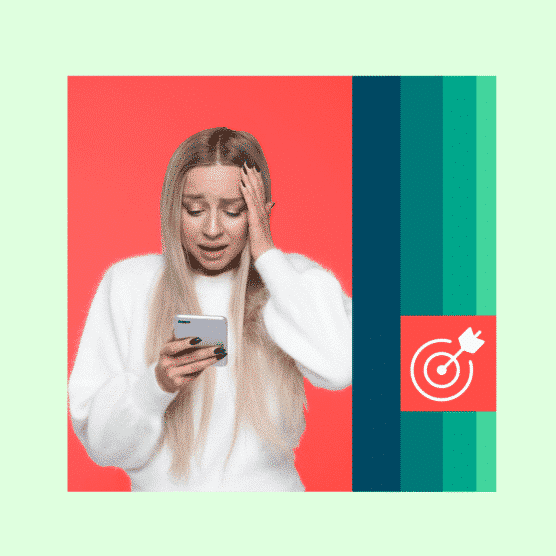
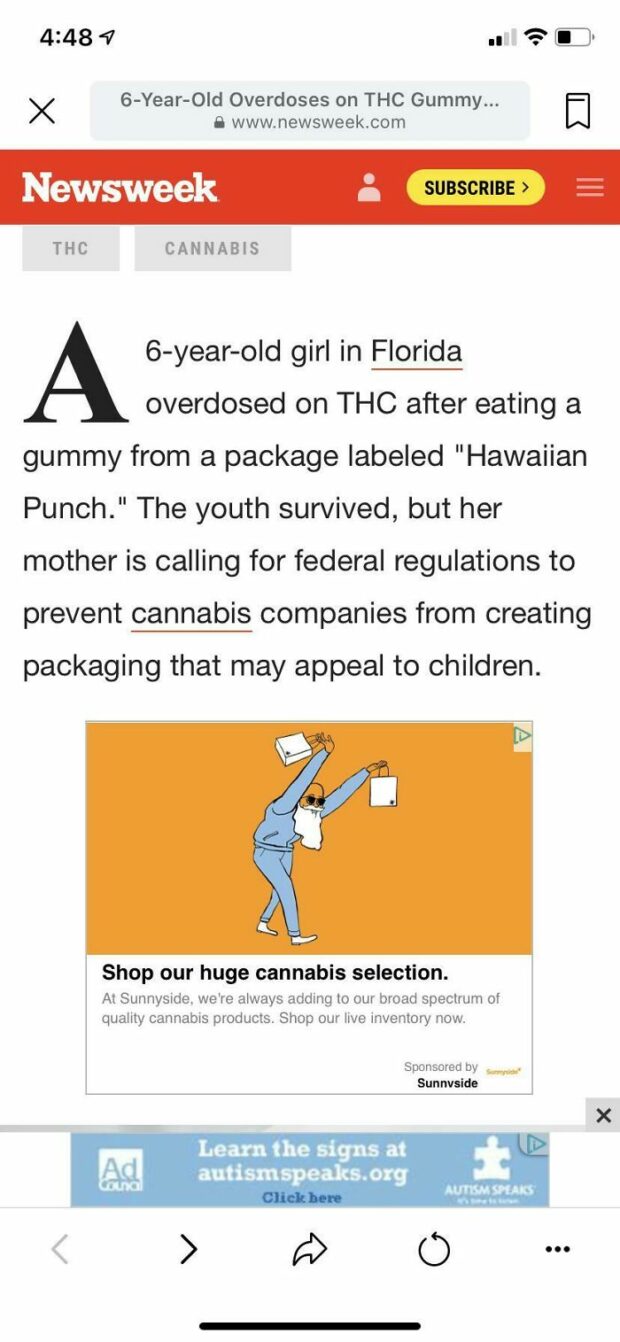

![How To Advertise on Facebook in 2022 [Complete Guide] | Hootsuite](https://blog.hootsuite.com/wp-content/uploads/2020/03/Advertise-on-facebook-556x556.png)
